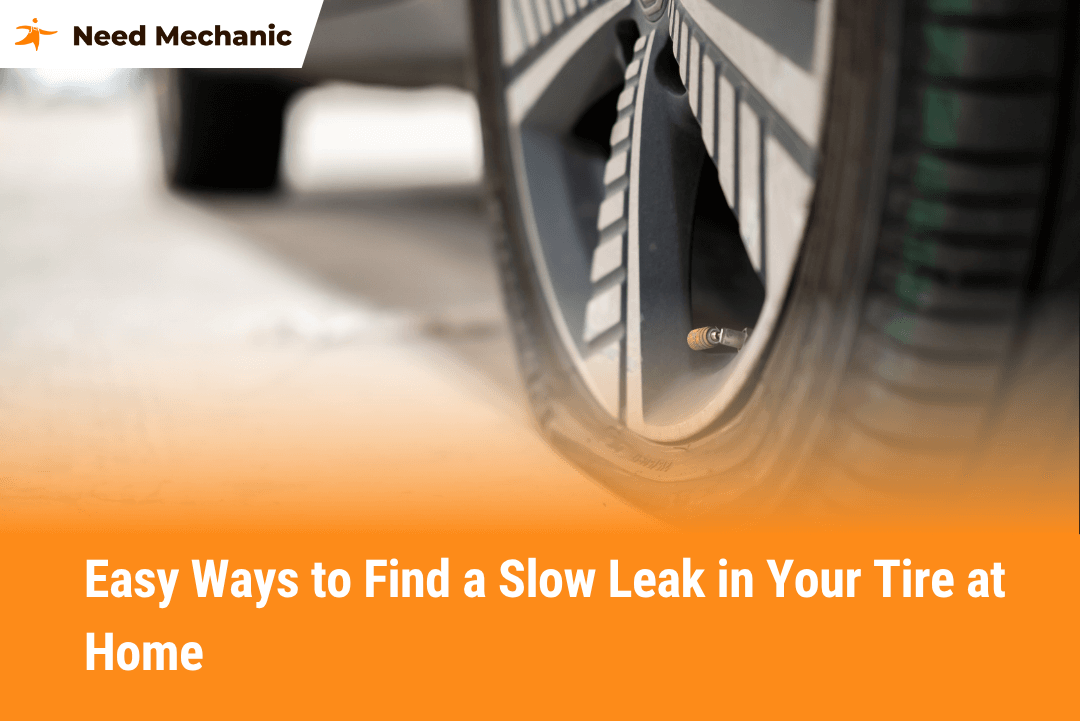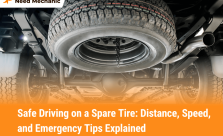To find a slow leak in a tire, start by visually inspecting the tread, sidewalls, and valve stem for any damage or embedded objects. Then spray the tire with a soap and water solution, bubbles will form where air is escaping. You can also use a tire pressure gauge over several days to track gradual pressure loss, or submerge the tire in water to spot hidden leaks.
These methods are simple, effective, and require little to no mechanical experience. Whether you’re dealing with one tire that keeps losing air or want to catch a leak early, knowing how to find a slow leak in a tire can prevent unexpected flats, improve driving safety, and help you avoid unnecessary tire replacements. This step-by-step guide will walk you through everything you need to diagnose the problem and fix it before it gets worse.
Why Slow Tire Leaks Matter More Than You Think
Some drivers think it’s fine to just keep refilling a tire every few days, but that’s a risky game. A slow leak doesn’t just waste your time; it can put your vehicle and safety in danger. Here’s why slow leaks deserve your attention:
- Decreased gas mileage: Underinflated tires increase rolling resistance, making your engine work harder.
- Uneven tire wear: Constantly low pressure wears the tread unevenly, shortening the life of your tires.
- Poor handling and braking: Low air pressure affects how your car grips the road and responds in emergencies.
- Risk of blowouts: A slow leak can turn into a sudden tire failure, especially on highways or during hot weather.
The longer you wait to find and fix a leak, the higher your chances of needing a full tire replacement or worse, ending up with a blowout.
How to Know If You Have a Slow Leak in a Tire
Before diving into inspection and testing, let’s make sure you actually have a slow leak. Here are some common signs people often search for when trying to diagnose this issue:
1. The Tire Pressure Light Keeps Coming On
Modern vehicles have a TPMS (Tire Pressure Monitoring System) that alerts you when one or more tires lose pressure. If the light turns on repeatedly after you top off a tire, chances are there’s a slow leak.
2. One Tire Is Always Low
If you’re filling up the same tire every week while the others are holding steady, that tire is probably leaking air somewhere.
3. Vehicle Pulls to One Side
Low tire pressure in just one tire can cause your car to veer slightly while driving straight.
4. Visible Sag or Flat Spot
Even without a warning light, a slow leak may cause one corner of your car to sit lower, especially after it’s been parked for a while.
5. Unusual Tire Wear Patterns
A slowly leaking tire will often wear down unevenly, especially along the edges.
If you’ve noticed any of these signs, it’s time to investigate. Let’s move on to the best ways to find the leak.
What Causes a Slow Leak in a Tire?
Before checking for the leak, it’s helpful to understand what might be causing it. Here are the most common culprits:
- Puncture from a nail or screw: These can cause slow leaks if they only partially penetrate or don’t create a wide hole.
- Damaged or corroded rim: If the seal between the tire and the wheel is weak, air can escape slowly.
- Cracked valve stem or valve core: The small rubber piece where you add air can age or become damaged.
- Bead leak: Air can escape from the edge of the tire where it seals against the wheel.
- Old patch or plug failure: Sometimes previous repairs wear out over time.
Knowing these can help guide your inspection more accurately.
Step-by-Step: How to Find a Slow Leak in a Tire
Now let’s walk through a simple, step-by-step process to locate the leak.
Step 1: Get the Right Tools and Prep the Area
You don’t need a mechanic’s toolbox. Here’s what you’ll need:
- Spray bottle (or small bucket)
- Dish soap
- Water
- Tire pressure gauge
- Air compressor (optional)
- Flashlight
- Marker or chalk
- Gloves and eye protection (optional but smart)
Start with a cool tire. Heat can expand air inside the tire and give false readings.
Step 2: Visually Inspect the Tire
Before testing anything, take a close look at the tire:
- Check the tread: Look for sharp objects like nails, glass, or screws.
- Inspect the sidewalls: Look for bubbles, cracks, or cuts.
- Examine the valve stem: Wiggle it gently if it’s loose or cracked, it may be the problem.
- Look at the wheel itself: Check for bent or corroded rims, especially if you live in a snowy or coastal area.
Mark anything suspicious so you can test those spots more closely.
Step 3: The Soap and Water Test (Best DIY Method)
This is one of the most searched DIY leak detection methods, and for good reason it works.
How to do it:
- Mix dish soap with water in a spray bottle (about 1 part soap to 3 parts water).
- Inflate the tire to the correct pressure.
- Spray the soapy water generously on:
- Tread area
- Sidewalls
- Around the valve stem
- The bead (where the tire meets the rim)
- Watch closely for bubbles. If a steady stream of small bubbles appears, you’ve found your leak.
- Mark the spot.
This method is cheap, safe, and doesn’t require removing the tire.
Step 4: Check the Valve Stem
Sometimes the issue isn’t in the rubber at all it’s the valve.
- Spray the soapy solution directly on the valve stem.
- Pay close attention to the valve core (the part inside where you insert the air hose).
- If it bubbles or hisses, the valve may need tightening or replacing. A valve core removal tool costs only a few bucks.
Step 5: Test Tire Pressure Over Time
This method works great when the leak is too small to show up with soap and water.
Here’s how:
- Use a tire pressure gauge to record all four tires’ PSI (pounds per square inch).
- Repeat the reading at the same time each day, preferably in the morning.
- If one tire consistently drops 2–5 PSI while the others remain steady, you’ve confirmed a leak.
Pro tip: This is especially useful if you’ve recently had tires filled and want to check for a slow leak after driving.
Step 6: Submerge the Tire (If You Can Remove It)
If the leak remains hidden, try this more in-depth method:
- Remove the tire and submerge it in a large tub of water (a kids’ pool or even a clean trash can may work).
- Watch for bubbles to form. Rotate the tire slowly.
- Bubbles = leak.
This is more work but nearly foolproof.
What to Do After You Find the Leak
Now that you’ve located the problem, here are your options:
- Tread puncture: Plug it yourself with a tire plug kit or take it to a shop for a patch.
- Sidewall damage or bead leaks: These are usually not repairable replacement is safer.
- Valve core issue: You can tighten or replace the core with a valve tool.
- Corroded rim: May need to be cleaned, sealed, or replaced.
If you’re unsure, have a tire professional inspect it.
When You Should Replace the Tire Instead of Repairing It
Not all leaks can or should be fixed. Here’s when to replace:
- Leak is on the sidewall
- Tire is bald or tread is under 2/32 inch
- Multiple punctures or previous repairs
- Large gashes or deep cracks
Driving on a weak tire is a safety risk, especially at highway speeds.
How to Prevent Future Tire Leaks
Once you’ve dealt with a slow leak, you’ll want to avoid it happening again. Here’s how:
- Check tire pressure monthly using a gauge not just the warning light.
- Rotate your tires regularly to avoid uneven wear.
- Avoid potholes and road debris as much as possible.
- Replace valve caps to keep dirt and moisture out.
- Clean rims periodically, especially in winter climates.
Being proactive can add thousands of miles to your tire’s lifespan.
Final Thoughts: Catch It Early, Drive Safer
Finding a slow leak in a tire doesn’t need to be expensive or complicated. By using simple, effective methods like the soap-and-water test, daily pressure tracking, and visual inspection, you can catch a leak early before it leads to flat tires, poor fuel economy, or worse.
Take a few minutes today to check your tires. A small bubble now might save you from a blowout later.
FAQs
What’s the fastest way to find a slow leak?
The soap and water spray test is fast, cheap, and works well for most punctures and valve leaks.
Can a slow leak get worse over time?
Yes. Punctures and weak valve stems often get worse, especially in extreme temperatures or high-speed driving.
Is it safe to drive with a slow leak?
Only for a short distance. If you keep refilling the tire, it may seem okay—but it’s still dangerous.
How much does it cost to fix a slow tire leak?
Basic repairs like plugs or valve replacements can cost $10–$30. Replacing the tire costs more, depending on size and brand.
Can a tire lose air without a visible hole?
Yes, tires can lose air from hidden damage, a faulty valve stem, a poor rim seal, or dry rot—even with no visible puncture.
How long does it take for a slow leak to flatten a tire?
It depends on the leak size. Some take days or weeks, while others can deflate a tire overnight. Regular pressure checks help catch it early.
Will tire sealant fix a slow leak permanently?
Tire sealants can help temporarily, but they are not permanent. Sidewall, bead, or valve leaks usually require a proper repair or tire replacement.




Leave a Reply